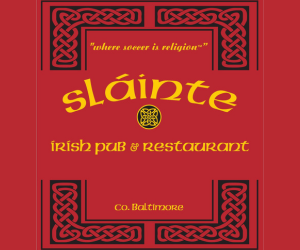Anthropologist Linda Rabben shares her local expertise and new book on the social history of stained glass in 20th Century Baltimore homes that you’ve driven by every day of your life. A fascinating deep dive from churches to stoops to Roland Park aristocracy a century ago.
SUMMARY KEYWORDS
baltimore, stained glass windows, houses, stained glass, people, windows, churches, linda, glass, history, neighborhood, wife, learn, built, architecture, anthropologist, week, started, northeast, book
SPEAKERS
Linda Rabben, Nestor Aparicio
Nestor Aparicio 00:01
Welcome back, WN S T tassel Baltimore. And Baltimore positive we are positively keeping abreast of all things going on with the Ravens here this week Luke is out knowings Mills will be catching up on all that I’ll be giving away. Raven scratch also in the Maryland crabcake tour. This week, I have my pappy shirt on, because we’re going to be there for Thanksgiving on the 21st we’re going to be the papists in Parkville. We already done on Valley Cockeysville. We’ve done Bel Air, we’ve done Glenburnie it’s time to get to the original location, we’re going to be Parkville and 21st, check out all of our crabcake tour stop dates out of Baltimore positive and our social media. It’s all also brought to you by window nation and our friends at Jiffy Lube where I got my oil change over Dundalk. So this is gonna be a fun one because it’s a little outside the box for me, I’ve been doing a whole lot more things in regard to non sports related things whenever I get the opportunity. My friend Karen, who’s a bit of publicist and a friend for three decades through this opportunity to talk about architecture, anthropology and one of my wife’s favorite things. So I noticed that a lot stained glass and my wife went to a glassblowing a class at one point and she’s always seeing churches always seeing in Baltimore what my wife is from New Hampshire, but spent time in her formative years in Boston looking at architecture. She’s literally as we speak in Europe right now running around Paris and Amsterdam and Cologne and Frankfurt, Germany and seeing architecture. So this book is the first illustrated book about and this is a Baltimore positive thing. Baltimore stained glass the book is through a glass darkly exploring the evolution of glass decoration. And there’s a real history to that, because there’s a real history here in Baltimore, in regard to religious facilities and churches and public buildings over the last 200 years. She is I guess, an anthropologist, but also involved in architecture in some way. Linda rabbit is our guests though the book is through a glass darkly to social history of stained glass in Baltimore, all I see is pretty glass. Linda, please educate me. How are you today?
Linda Rabben 02:11
Pretty good, thanks.
Nestor Aparicio 02:12
Well, how does someone write a book and study the history of stained glass in Baltimore?
Linda Rabben 02:20
No, I kind of fell into it, or rather walked into it. We moved to Baltimore from Montgomery County about two and a half years ago. And it was the pandemic. But I wanted to get to know my neighborhood in northeast Baltimore. So I started walking around. And I noticed a lot of stained glass windows on houses in northeast Baltimore.
Nestor Aparicio 02:43
My wife sees them all the time. And she says the same thing she’s like, that’s unique. I mean, we think of the stoops and the marble steps and row houses. I mean, I grew up in Dundalk. I’ve lived here my whole life. My wife literally is in Amsterdam right now, there are very few places in the world where you can go somewhere, and it looks like Baltimore, Amsterdam has a little bit of that vibe with the water. But then you get inland and you start to see other things, aside from the port part of this that are part of something that they don’t have this in Dallas, right? They don’t have this in Orlando.
Linda Rabben 03:16
No, no, because I haven’t looked in those cities. But I was impressed by how much I saw. And the more I looked, the more I saw, so I got kind of obsessed with it. And I was walking around taking pictures. Sometimes I would encounter neighbors, they’d be out in their front yards doing something with the garden. And we’d have little conversations. And I’d ask them about their house. You know, how old is your house? And I’d ask them about the windows. And usually they didn’t know very much about the windows. Some people turned out to be connoisseurs of stained glass windows. I’ve encountered a lot of them. People who did you say your wife took a class in glassblowing? Yes, a lot. Yeah, a lot of people have done that. Particularly in Baltimore, there are a couple of places that people mentioned. Artists corner is one of them. It’s a billy erode. In overly so I would talk about them. And sometimes as the pandemic went on, and people got vaccinated and weren’t so scared anymore. People would say, hey, why don’t you come inside and take a picture of the windows? Because they look much better from inside than from outside. So that’s how I got to know my neighbors. So people bought homes
Nestor Aparicio 04:38
and these windows are in the home and they knew some history about how it happened. Yeah, because,
Linda Rabben 04:44
you know, they’d see on the deed, or on the tax statements when the house was supposedly built. And a lot of times those records are inaccurate. But so they could say, Well, I think this House was built in 1923. And that would be consistent with the windows being an original feature of the house. The reason I say that is because Baltimore kept expanding, there were two annexations. In Baltimore. One was in 1888. And the other was in 1918. So people started flocking out to suburbs that had been in Baltimore County. But we’re now in Baltimore City. And so builders would be building groups of houses. So like on Northern Parkway near where I live, you’ll see a long row of detached houses. They’re exactly the same. They were all built probably in the 1920s. And they all have stained glass windows on the side of the house, usually between a fireplace. So there was clearly there was a pattern to this development. And I just had to do research to find out what that pattern was. But what I couldn’t find out was who made these windows? When did they make them and where were they made? Usually, they’re not signed. And they’re not dated. Sometimes in churches, especially if it’s a Tiffany window, you will see a little signature down at the bottom right hand corner or left hand corner, and maybe the date, but for most of these house windows, nothing. So it got to be kind of a wild goose chase to try to figure that out. So I switched my focus or kind of expanded what I was looking at, and wanted to find out why in certain areas, there are a lot of houses with stained glass windows, and in other areas, you don’t see them. So I had to learn about the history of Baltimore, which I’m not from Baltimore, this is the first time I’ve lived here. So there was a lot to find out. So I read some really good local histories. You’ve got a squad of local historians in Baltimore? Yes,
Nestor Aparicio 07:06
we do. I’ve had a lot of a lot on talking about redlining and neighborhoods. And I mean, we have a very, very sordid history. And people say, Well, how did your town get so messed up? And? Well, it’s, I mean, if you if you, if you go back three, four generations back, we’re talking, there were a troubled community in that way. And and I don’t know what how stained glass would work into that. But I would think religion would be a part of it. And churches, people see something in the church and say, I want a home with that. And, and probably also just the functionality of glass, and being something you had to have, and the decorative part of what would make a house look a little different that somebody would want to buy it 100 years ago, right?
Linda Rabben 07:50
Yeah, there. Yeah, several aspects to that. So it’s to protect people’s privacy. You know, you’re kind of enclosed with the stained glass. And they’re pretty colors that you can look at, and it’s quite delightful. People can’t see in, and you can’t see out either. So it’s this kind of moon like feeling that you have of being protected inside your property. So that’s, that’s one thing about it. And what was the the other part that just religion
Nestor Aparicio 08:21
and church and builders and probably just the, the marketing part of making it something? If you had a Catholic Church and saw it say, that looks like that looks like my church, it looks like a place I want to reside? Yeah,
Linda Rabben 08:37
that that is a big part of it. Especially in the early 20th century, churches started decorating with stained glass probably in the mid 19th century. And wealthy people were putting stained glass windows, very elaborate ones in their mansions. So if you go, for example, to Clifton, you know, this amazing mansion in Clifton with the tower and it was Johns Hopkins summer home. And he’s got stained glass windows from the 1850s. That’s pretty early. And they were probably made by the first company to make and install stained glass. That was the Garin Hart company. So there’s these two origins. Yes, churches, especially towards the end of the 19th century. You have to realize stained glass has always been a luxury item,
Nestor Aparicio 09:32
just to say it was a status, a status because of its beauty and the way the light refracted through it probably right. And
Linda Rabben 09:40
it was complicated to make its handmade, although nowadays you can make stained glass on a machine, but the custom made ones are the ones that cost a lot of money. And very often in churches, there will be biblical scenes or if they could afford a Tiffany when though they might have a very beautiful, elaborate landscape. So it was a status symbol, it was a marker of upward mobility. So if you were moving out of the crowded center of town, you might go up to northeast Baltimore. And you would have space, that great luxury of space, you’d have space inside your house, no more little cramped row houses, you’d have a detached house. And you would also have space around the house. So other people couldn’t get too close. And you would live in a neighborhood where there were other people just like you, they’re pretty homogeneous. They’re racially segregated. They’re religiously segregated, they’re ethnically segregated neighborhoods. And as people began to move up, socially and economically, they, they imitated their betters, the very rich people who could afford to put a Tiffany window in their house. But the patterns that the builders chose in the new houses, let’s say in the 1920s, were much simpler than those elaborate Tiffiny windows that are earlier there from like the 1880s, to around 1910. And it was much easier and cheaper to make those abstract small windows to put in people’s houses after the First World War, right, especially after the First World War. And in some cases between 1900 and the First World War. So you’ve got builders, and they’re ordering these windows in bulk. This gave the Glass Studios a new lease on life for about 30 years. Because of you know that rich people were no longer so interested in having stained glass as it became more popular and more vulgar. They didn’t want to do that they were going to be trendsetters. So they were looking at different ways to decorate their houses. If you go to let’s say, homeland, or Roland Park, and you will see a lot of houses, their colonial houses, they don’t have stained glass windows in them. Because they were built in the 1920s when rich people were no longer interested. So and it wasn’t the vote for stained glass.
Nestor Aparicio 12:29
It’s like white wall tires or something, right? Like it was a fad, right? Like literally right? Or,
Linda Rabben 12:37
you know, all kinds of stuff that you put on the outside of your house. So the high point of it is from around, let’s say 1918, to the Great Depression. And then people can’t afford stained glass anymore. You’ll see fewer houses with stained glass windows in them. There are some from the 1930s. But by the time of the Second World War, it’s done. And I think that’s partly because the big glass factories, they had to repurpose to make war material. They weren’t going to make decorations for people’s houses. It was a time of austerity. Everything was going for the war effort.
Nestor Aparicio 13:22
So you’re saying part of the roaring 20s was having a sexy stained glass, you know, five miles from downtown in Parkville or Hamilton and 100 years ago, that was I have stained glass that’s that was like, like having a Cadillac didn’t have cars then Right? It was literally a luxury sign. Right? Yeah.
Linda Rabben 13:42
And those people that were moving out there that the housing developments were advertised as being places where you could raise chickens, you could have an orchard in your backyard. So it’s a kind of retreat to an idealized notion of the countryside. And the irony of it is as that people are flocking out to the suburbs, they’re destroying what they went there to have the benefit of. So instead of having a view of the countryside, what you’ve got is just more basically urban neighborhoods that are growing up over time. So it is a it is a history that Eric Holcomb tells in city, a suburb. And Eric Holcomb is the director of the chap commission for historic and architectural preservation in Baltimore. And he wrote this really wonderful book. It has a history of Northeast Baltimore, from 1660 to 2005, when he published the book, so I learned a lot from that book, and it helped me make sense of why there are so many stained glass windows in neighborhoods that developed during that period, let’s say broadly 1900 to 1940, but you won’t find them in my house. For example, my house was built in 1952, no stained glass, it was passe by that time. And this neighborhood, it was a segregated white, middle class neighborhood, and didn’t become an integrated neighborhood until maybe 2025 years ago. So all of that is, you could take any kind of what anthropologists call material culture, like stained glass window, or some kind of sculpture, any kind of decoration on a house and use it to tell the story of the history of the city. So it provides a microcosm of what’s going on with the development of Baltimore, as an important and rather wealthy urban area in the late 19th, early 20th century.
Nestor Aparicio 16:03
Anthropologist Linda rabbit is our guest. The book is the first illustrated book about Baltimore stained glass. And I think we’ve all seen it, my wife has seen it. If you’ve driven around Baltimore through a glass darkly, the social history of stained glass in Baltimore, the books available now, you can Google that find it. And Linda is an anthropologist by trade who came here a couple of years ago, if you just joined our segment, trying to learn about our city, you know, I went to my mother’s roots in Abbey Ville, South Carolina two weeks ago, my mom’s been dead five years ago, five years now, she was born in 1919. So I had a much older mother. And I went to and I saw these houses when when I was a child, when I was down there chasing crickets, with these long porches, and the you know, the rocking chairs and the swings and the sun. And my wife’s from New Hampshire and comes here. And when she goes to a neighborhood, like where you’re talking about where you live to Hamilton northern Parkway, the houses with the backyards that are single houses with porches, it looks like her hometown, Manchester, New Hampshire. And it has that that sort of that part of it. But the way Baltimore’s grown up with the history that it’s had from being an urban center, all the way out to Bel Air and Westminster and down into really, where Baltimore, Washington meet your montgomery county, originally, but but how all this thing got going, I think there are layers of all of it, where you could see white flight, you can see where certain populations ethnically, religiously moved in different areas as well as economically, for you to come into this and sort of fly into this couple years ago, and take this project on as being an anthropologist, I would first say the first thing is that the fact that 100 years later, a lot of this stained glass is still there. I often think like what happens when it breaks, right? Like I is it, I don’t say indestructible, but there’s some of this glass, just, dare I say better made because it was made 100 years ago. And that’s why it’s still standing. Because glass breaks, don’t I say that’s my wife and my kitchen all the time, which is why I try to have plastic in the kitchen.
Linda Rabben 18:05
Well, it is fragile. And it’s held together, the older Windows are held together with lead. And the lead starts to deteriorate after about 80 years. So sometimes pieces will fall out of glass or it starts to buckle and bulge. And so it has to be maintained. And a lot of stained glass in Baltimore has been lost. It’s been lost because people didn’t take care of it. And it started to collapse, or somebody decided to put in storm windows or vinyl siding. And they would just take the windows out between about
Nestor Aparicio 18:46
taking them out probably cheaper than repairing them to some degree Correct. Might be
Linda Rabben 18:50
yes, yeah. It from about 1970 to the early 2000s. These windows, especially transoms. Were being stolen out of houses. And people would call the cops and say, hey, my transom has been stolen. And the cops was usually little they could do and the theory was that there was some kind of gang of thieves that was selling these windows outside of Baltimore in the neighboring counties. But it went on for a long time. And there were churches where some of the windows were stolen from
Nestor Aparicio 19:26
something that could break in half while you’re stealing it. You got some stuff
Linda Rabben 19:29
to be careful. Yeah, you have to be careful. So yes, a lot has been lost and it does have to be maintained. There are stained glass makers who are making a living by restoring and repairing and reconstructing stained glass windows. Well, it
Nestor Aparicio 19:45
must be fun for you to talk to right. Yeah,
Linda Rabben 19:48
I interviewed several of them for the book. And, you know, they were thrilled that somebody was paying attention to their craft. Some of them are getting on they’re ready to to retire, and they don’t know who’s going to take over once they’re gone. So the craft needs to be protected and preserved. And in Baltimore, we’ve got such a rich heritage, and we need to take care of it. Well,
Nestor Aparicio 20:14
you got a lot of pictures here. I’ll send anybody out through a glass darkly you can go around the city and see this stuff. I love that anthropologist Linda Rabb was offered up for Baltimore positive your leg, and we could chat about something that my wife has wondered. When she when she gets back home. She’s gonna be like, Oh, you had stained glass. Leon. You know, I’ve often wondered, because we drive through those neighborhoods all the time. So Linda, I’m gonna send everybody out. It makes a perfect gift. If you’re of the mindset and like to learn about these type of things through a glass darkly, the social history of stained glass in Baltimore, learn more see more, I learned a little bit I think the whole audience. Thanks for making time for us today. Linda,
Linda Rabben 20:48
can I plug an exhibition? Please do tell us tell us all about it. I’m curating an exhibition of the work of local stained glass makers. It’s going to open at the peel museum to 25 Holiday street Across from city hall. And the opening is November 18. That’s a Saturday two to 4pm And please, everybody come there’ll be free cookies.
Nestor Aparicio 21:12
Well, you got my attention. I’ll tell you that right now. Linda Robin and the book is out. You can learn more. There you go. The website you got the Facebook as well. I learned more about it’s our a BB e n if you’re looking for Linda, she is local and a associate research professor of anthropology smarter than me at the University of Maryland. Go Terps I am Nestor we are wn st am 1570, Towson Baltimore and we never stop talking. Baltimore positive stay with us.
































